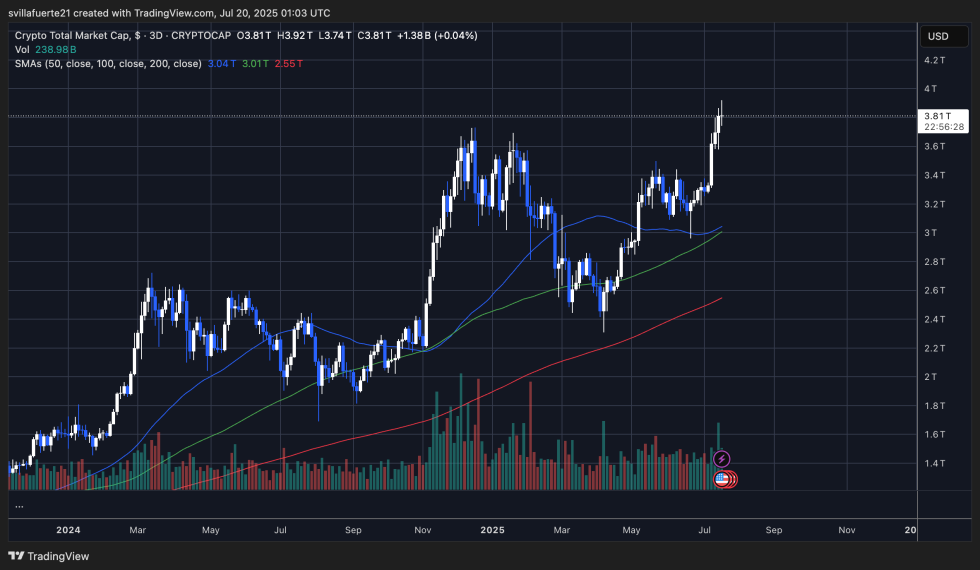
content, reviewed by leading industry experts and seasoned editors. Ad Disclosure
On Friday, US President Donald Trump signed the GENIUS Act into law, marking a pivotal moment for stablecoin regulation in the United States. After months of debate and two previous rejections, the bill finally passed through Congress, setting a clearer legal framework for payment stablecoins and their role in the broader digital economy. The legislation aims to boost innovation while reinforcing the US dollar’s position in the digital financial system.
However, the bill did not pass without resistance. Among the most vocal opponents was Rep. Marjorie Taylor Greene, who represents Georgia’s 14th District and serves as Chairwoman of the DOGE Committee. Greene reaffirmed her vote against the GENIUS Act, citing concerns that it lays the groundwork for a Central Bank Digital Currency (CBDC) without explicitly banning it. Her position echoes a wider debate in Washington over the future of digital currencies, surveillance risks, and financial freedom.
Despite the pushback, the GENIUS Act’s passage reflects a growing bipartisan consensus that regulatory clarity is needed to foster crypto innovation in the US. While not all voices are aligned on its implications, the bill is now law, and its real-world impact on stablecoins and DeFi could be felt in the months ahead.
Marjorie Taylor Greene Slams GENIUS Act
Rep. Marjorie Taylor Greene, Chairwoman of the DOGE Committee, delivered a strong rebuke of the GENIUS Act following its passage and President Trump’s signature on Friday. Greene, who voted against the bill, warned that the American public “hardly has any idea what it is, what it means, and what passed.” In her statement, she called the bill a Trojan horse for Central Bank Digital Currency (CBDC) development, stating, “This bill regulates stablecoins and provides for the backdoor Centralized Bank Digital Currency.”
Greene has long opposed any legislation that might open the door to CBDCs, arguing that a cashless society controlled by government-issued digital currency could be weaponized against US citizens. “Do you actually trust your government to never do that to you?” she challenged. “I don’t.”
While Greene opposed the GENIUS Act, she voted yes on the Anti-CBDC Surveillance State Act, a bill that would ban the Federal Reserve from issuing a CBDC. Despite House approval, Greene warned that the Senate lacks the votes to move the bill forward.
She also supported the Clarity Act, which passed the House and includes provisions for self-custody and clear regulatory guidelines for digital assets. However, she promised to vote no if self-custody protections are removed in Senate revisions. “The most important thing that needs to remain is protecting people’s self-custody of their digital currency.”
Referencing the US exit from the gold standard in 1971, Greene argued the country is again at a crossroads—this time moving from tangible cash to a fully digitized currency system. “Your ability to buy and sell will ultimately be held in digital accounts controlled by the banks and the government,” she warned.
Crypto Market Cap Analysis
The total crypto market capitalization has broken decisively above the $3.6 trillion level, reaching a new yearly high at $3.81 trillion, as shown in the chart. This breakout comes after several weeks of consolidation and signals renewed bullish strength across the digital asset space. The move was supported by strong green candles and increasing volume, suggesting broad participation across majors and altcoins.
 Crypto total market cap. | Source: TOTAL chart on TradingView
Crypto total market cap. | Source: TOTAL chart on TradingViewImportantly, the breakout confirms a bullish structure, with higher highs and higher lows forming since the June bottom. The 50-day simple moving average (SMA) sits around $3.04T, and the 100-day SMA nears $3.01T — both significantly below current price levels, reinforcing the strength of the uptrend. The 200-day SMA at $2.55T also confirms the long-term bullish posture.
This breakout coincides with a backdrop of legal clarity in the US, particularly after the signing of the GENIUS Act, which boosts confidence in stablecoins and tokenized finance. Bitcoin and Ethereum continue to lead the charge, but altcoins are now gaining momentum as capital rotates across the ecosystem.
Featured image from Dall-E, chart from TradingView

Editorial Process for bitcoinist is centered on delivering thoroughly researched, accurate, and unbiased content. We uphold strict sourcing standards, and each page undergoes diligent review by our team of top technology experts and seasoned editors. This process ensures the integrity, relevance, and value of our content for our readers.

















 English (US) ·
English (US) ·